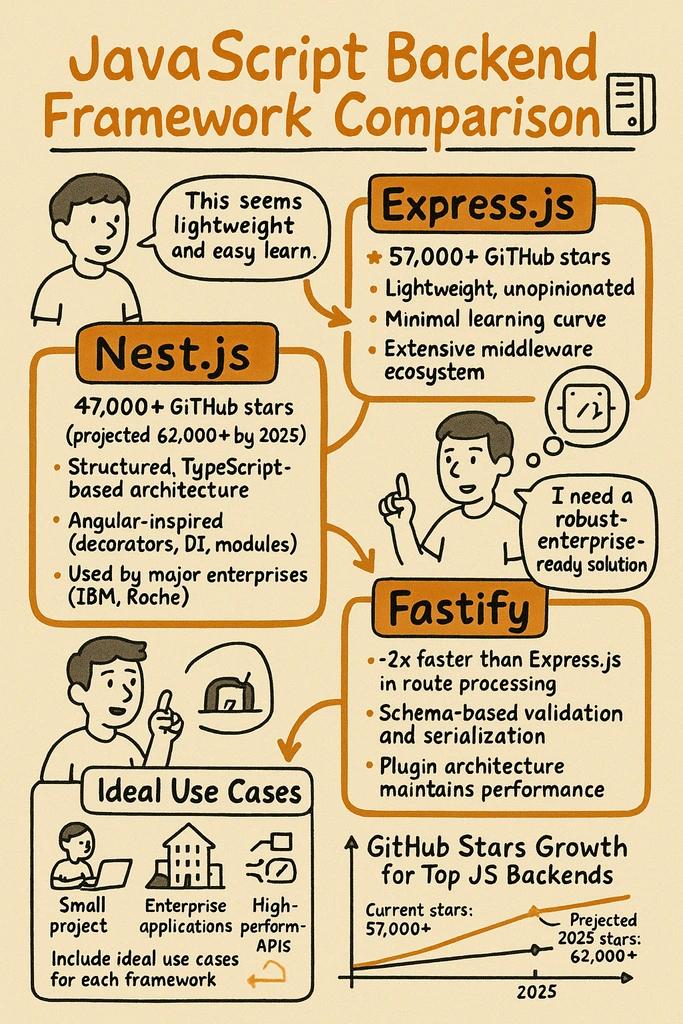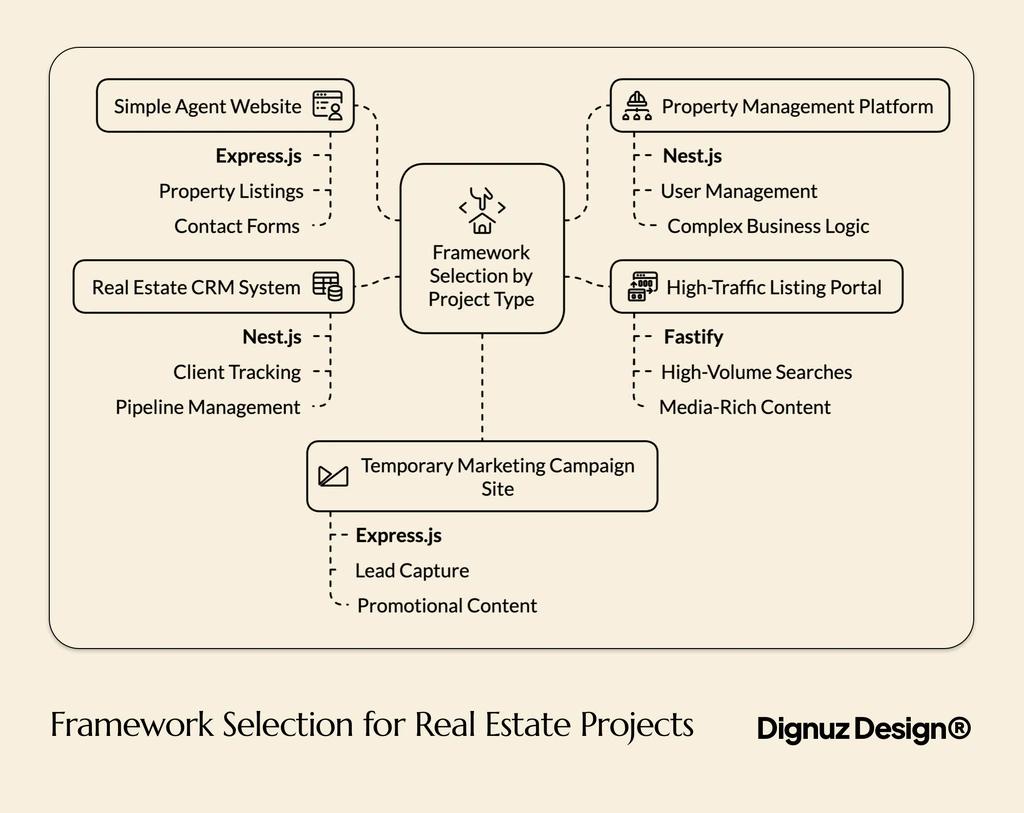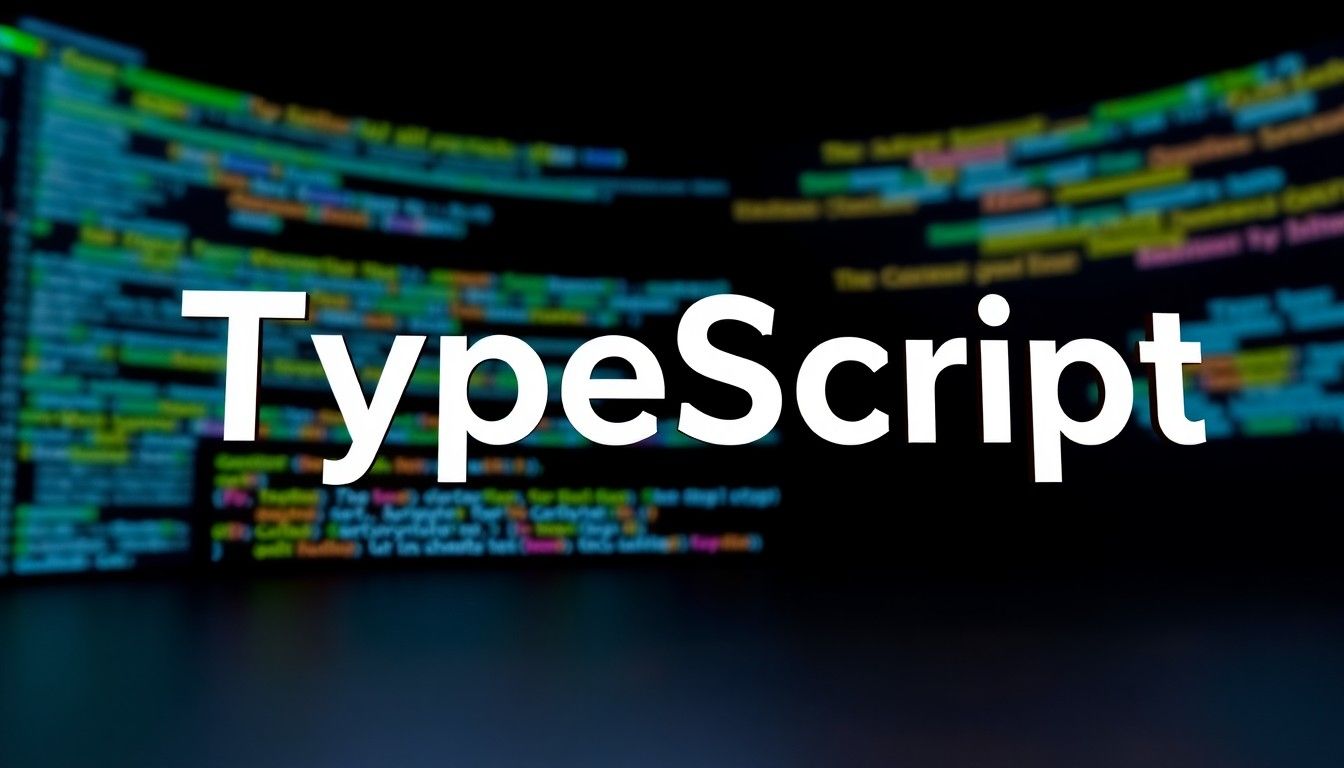JavaScript Backend Frameworks

Selecting the right backend framework for your web application can determine its success or failure. This choice affects everything from development speed to long-term maintenance and performance – all crucial factors for real estate websites that need to showcase properties effectively while handling user interactions smoothly.
For real estate professionals looking to build custom web solutions, understanding the strengths and limitations of different JavaScript backend frameworks helps you make informed decisions that align with your business goals and budget constraints.
This guide examines the top JavaScript backend frameworks currently available, with practical insights for choosing the best option for your specific needs. We'll focus on real-world applications relevant to real estate web development.
Understanding JavaScript Backend Frameworks
Backend frameworks provide the foundation for web applications, handling server-side operations like database interactions, user authentication, and business logic processing. JavaScript frameworks extend the language's capabilities, allowing developers to create robust server applications using Node.js.
These frameworks bring structure and efficiency to development processes. Rather than writing everything from scratch, developers use pre-built components and follow established patterns. This approach saves time and helps maintain consistent code quality.
The popularity of JavaScript for backend development stems from its ability to use the same language on both frontend and backend. This consistency simplifies development and makes resource sharing between teams more efficient.
Why Backend Frameworks Matter for Real Estate Websites
Real estate websites have unique requirements that make the backend framework choice particularly important. They often need to handle property databases, user accounts, search functionality, and integration with mapping services or 3D visualization tools.
The right framework supports these features while ensuring good performance even when displaying media-rich content like high-resolution images or 3D property tours. Framework selection directly impacts site speed, security, and the ability to adapt as your business grows.
Backend stability is especially critical for real estate professionals whose websites serve as primary business tools. Downtime or poor performance can mean lost leads and damaged client relationships.

Key Considerations When Choosing a Backend Framework
Before examining specific frameworks, we should understand the key factors that should guide your selection process. This evaluation framework helps match technical capabilities with your business needs.
The ideal choice balances technical excellence with practical considerations like your team's expertise and project timeline. A technically superior framework might not be the best choice if it requires extensive training or extends development time beyond acceptable limits.
Performance and Scalability
Performance affects user experience directly. Slow-loading property listings or laggy search results frustrate potential clients and increase bounce rates. Frameworks differ significantly in how they handle requests and manage server resources.
Scalability becomes important as your real estate business grows. Your website needs to handle more listings, users, and interactions without requiring a complete rebuild. Some frameworks excel at small projects but struggle with larger applications.
Consider both current needs and future growth when evaluating performance characteristics. The framework that works for a single agent might not suit a growing brokerage with dozens of agents and thousands of listings.
Learning Curve and Development Speed
Every framework requires learning time. Some offer a gentle introduction with minimal concepts to master, while others demand understanding complex architectural patterns before effective development can begin.
This learning curve directly impacts development costs and timelines. Simpler frameworks often allow faster initial development but might create limitations later. More complex options require greater upfront investment but can enable better long-term maintenance.
Your existing team's expertise matters too. If your developers already know a particular framework, switching to another might not be worth the productivity loss despite potential technical benefits.
Community Support and Ecosystem
Strong community support translates to better documentation, more available resources, and easier problem-solving. Popular frameworks benefit from extensive online tutorials, active forums, and regular updates.
The ecosystem surrounding a framework includes libraries, plugins, and tools that extend functionality. A rich ecosystem means you'll spend less time building common features from scratch and more time on your application's unique aspects.
For real estate websites, look for frameworks with good support for relevant features like geolocation, image processing, and authentication systems that might be needed for client portals.
Business Requirements and Budget Constraints
Technical considerations must align with business realities. Your framework choice should reflect your project's complexity, timeline, and budget. More complex frameworks often require more developer hours, increasing costs.
Consider both short-term development costs and long-term maintenance expenses. Sometimes paying more upfront for a framework that enables easier updates and extensions saves money over time.
For real estate businesses with seasonal fluctuations, also consider how easily the framework allows you to scale resources up or down based on demand patterns.

Top JavaScript Backend Frameworks
Now let's examine the leading JavaScript backend frameworks that deserve consideration for your web application. Each offers distinct advantages and best-fit scenarios.
These frameworks represent different approaches to backend development, from minimalist and flexible to structured and opinionated. Understanding these differences helps match framework characteristics to your specific project needs.
Express.js: The Versatile Standard
Express.js stands as the most widely used Node.js framework with over 57,000 GitHub stars, making it the go-to choice for many developers. (Source: Flatirons)
This lightweight, unopinionated framework provides fundamental web application features without imposing rigid structures. Developers appreciate its flexibility and minimal learning curve, which allows rapid implementation of both simple and complex systems.
Express shines in projects where development speed matters. Its straightforward approach makes it ideal for smaller real estate websites, agent landing pages, or prototype applications that need quick deployment.
The extensive Express ecosystem includes middleware for almost any functionality you might need. This modular approach lets you add only what's necessary, keeping applications streamlined and performant.
Nest.js: The Enterprise Solution
Nest.js represents a more structured approach to Node.js development. This enterprise-grade framework uses TypeScript with built-in support, providing stronger typing and better code organization for complex applications. (Source: Leeddev)
With over 47,000 GitHub stars as of 2024, Nest.js continues gaining popularity, especially for larger projects. (Source: Flatirons)
Major enterprises like IBM and Roche trust Nest.js for their applications, demonstrating its reliability for business-critical systems. Its adoption continues growing rapidly in corporate environments. (Source: Leeddev)
Nest's architecture draws inspiration from Angular, featuring decorators, dependency injection, and modules. This structured approach makes large codebases more manageable and supports clear separation of concerns.
For real estate platforms with complex requirements like property management systems, multi-user portals, or applications needing robust API development, Nest provides architectural patterns that support maintainability and scalability.
Fastify: The Performance-Focused Alternative
Fastify focuses on delivering maximum performance while maintaining developer-friendly features. Benchmarks show it processes routes approximately twice as fast as Express, making it an excellent choice for high-traffic applications. (Source: Dev.to/Leapcell)
This framework emphasizes both speed and developer experience. It offers schema-based validation, serialization, and a plugin architecture that allows extending functionality while maintaining performance benefits.
Real estate applications that expect high traffic volumes or need to process substantial data, like popular property listing sites or rental platforms, can particularly benefit from Fastify's performance advantages.
While newer than Express or Nest.js, Fastify has gained significant adoption among developers focused on application performance and efficient resource utilization.
Framework Comparison: Finding the Right Fit
Comparing these frameworks across key dimensions helps identify which best suits your specific project needs. Each excels in different scenarios based on its architecture, performance characteristics, and ecosystem.
The following technical comparison examines the fundamental aspects that differentiate these frameworks. This objective assessment helps match framework capabilities to your technical requirements.
Architecture:
- Express.js: Unopinionated middleware
- Nest.js: Modular dependency injection
- Fastify: Plugin-based architecture
Learning curve:
- Express.js: Beginner-friendly
- Nest.js: Steeper
- Fastify: Moderate
Performance:
- Express.js: Good
- Nest.js: Very good
- Fastify: Excellent
TypeScript support:
- Express.js: Optional
- Nest.js: Built-in
- Fastify: Optional
Microservices support:
- Express.js: Requires plugins
- Nest.js: Native
- Fastify: Via plugins
This technical comparison highlights the architectural differences between these frameworks. Express.js offers simplicity and flexibility, Nest.js provides structure and scalability, while Fastify delivers exceptional performance.
Beyond technical specifications, business considerations also play a critical role in framework selection. The following table examines factors that impact project timelines, budgets, and organizational fit.
Time to market:
- Express.js: Fast
- Nest.js: Moderate
- Fastify: Fast
Long-term maintenance:
- Express.js: Good
- Nest.js: Excellent
- Fastify: Good
Developer availability:
- Express.js: Very high
- Nest.js: Growing
- Fastify: Moderate
Enterprise readiness:
- Express.js: Moderate
- Nest.js: High
- Fastify: Moderate
Community resources:
- Express.js: Extensive
- Nest.js: Good
- Fastify: Growing
This business comparison reveals why Express.js remains popular for projects with tight deadlines or limited budgets, while Nest.js gains traction for enterprise applications where long-term maintainability justifies higher initial development costs.

GitHub Metrics and Popularity Trends
Community support and ongoing development activity provide insights into each framework's stability and future prospects. GitHub metrics serve as useful indicators of adoption and development momentum.
Express.js maintains its position as the most widely adopted framework with over 57,000 GitHub stars, demonstrating its enduring popularity and massive community. (Source: Flatirons)
Nest.js shows impressive growth trajectory, with star count projected to reach 62,000+ by 2025, indicating its rising status among enterprise developers. (Source: Leeddev)
While GitHub stars don't tell the complete story, they indicate developer interest and serve as one proxy for community size and activity around each framework.
Real-World Implementation Scenarios
Understanding how these frameworks apply to specific real estate web development scenarios helps clarify which option best fits your needs. Different project types benefit from different framework characteristics.
The following scenarios represent common real estate web applications and how framework selection impacts their development and performance. These examples illustrate practical framework application rather than theoretical comparisons.
Small to Medium Business Websites
Individual real estate agents or small brokerages typically need websites that showcase listings, provide agent information, and capture leads. These projects generally have straightforward requirements but need quick implementation.
For these scenarios, Express.js often proves ideal. Its simplicity allows rapid development without unnecessary complexity. The extensive middleware ecosystem makes it easy to add common features like contact forms, authentication for listing management, and image optimization.
The minimal learning curve also means development costs stay lower, an important consideration for small businesses with limited marketing budgets. Maintenance remains straightforward as long as developers follow good code organization practices.
Enterprise-Level Real Estate Platforms
Larger real estate organizations like property management companies, major brokerages, or real estate technology providers need more sophisticated platforms. These often include complex search functionality, user management, payment processing, and integration with multiple third-party services.
Nest.js excels in these scenarios. Its structured architecture supports complex business logic while maintaining code quality as multiple developers contribute to the project. The built-in TypeScript support improves code reliability and makes refactoring safer.
The modular approach Nest.js encourages aligns well with enterprise development practices and supports clear separation of concerns. For organizations expecting their platform to evolve significantly over time, this architectural foundation pays dividends through easier maintenance and extension.
Simple real estate agent website:
- Recommended Framework: Express.js
- Key Benefits: Quick development, cost-effective, simple maintenance
Property management platform:
- Recommended Framework: Nest.js
- Key Benefits: Structured architecture, better for team development, future-proof
High-traffic listing portal:
- Recommended Framework: Fastify
- Key Benefits: Superior performance, efficient resource usage, good scaling
Real estate CRM system:
- Recommended Framework: Nest.js
- Key Benefits: Complex data relationships, maintainable code, enterprise patterns
Temporary marketing campaign site:
- Recommended Framework: Express.js
- Key Benefits: Rapid deployment, minimum overhead, cost efficiency
This implementation guide demonstrates how project requirements should drive framework selection. The best technical choice always depends on specific business needs, timeline constraints, and long-term goals.
Integration with 3D Visualization Tools
For real estate developers showcasing new properties or off-plan developments, integrating 3D visualization tools requires specific backend capabilities. These interactive experiences demand efficient data handling and real-time processing.
When building backends for visualization-heavy applications, performance becomes particularly important. Fastify's speed advantages make it worth considering for applications where large 3D models or complex visualizations need to be served efficiently.
However, if the visualization tool requires complex business logic or integrates with multiple other systems (CRM, payment processing, etc.), Nest.js might offer better architecture for managing these relationships despite slightly lower raw performance.
Making the Final Decision: A Step-by-Step Approach
Choosing the right framework involves balancing technical requirements, business constraints, and organizational factors. This structured approach helps guide your decision-making process.
The following steps provide a methodical path to framework selection. This process helps avoid decisions based purely on trends or personal preferences, instead focusing on objective alignment with project needs.
Assessing Your Technical Requirements
Start by documenting your application's specific technical needs. Consider factors like expected traffic volume, data complexity, integration requirements, and performance expectations.
Ask these key questions:
- Will your application need to handle high traffic volumes?
- Do you require real-time features or primarily request-response patterns?
- How complex are your data relationships and business logic?
- What security requirements must your application meet?
- Will you need to integrate with specific third-party services?
These answers help identify technical constraints that might favor certain frameworks. For example, complex data relationships might benefit from Nest.js's structured approach, while high-performance needs might point toward Fastify.
Evaluating Your Team's Expertise
Your development team's existing knowledge impacts both development speed and code quality. Switching to an unfamiliar framework introduces learning curves and potential quality issues during the transition.
Assess your team's current skills and experience with each framework option. If your developers have extensive Express.js experience but none with Nest.js, the productivity gain from using familiar tools might outweigh the architectural benefits of switching.
Also consider your hiring pool if you plan to expand the team. Express.js developers are more abundant, while Nest.js or Fastify specialists might be harder to find or command higher salaries.
Planning for Future Growth
Consider how your application might evolve over the next 2-3 years. Will you add significant new features? Expect major traffic increases? Need to support mobile applications or additional channels?
Frameworks that seem adequate for current needs might become limiting as your application grows. Conversely, implementing an overly complex framework for a simple application that won't expand significantly creates unnecessary development overhead.
For real estate businesses expecting significant growth, choosing a framework that supports easy scaling and maintenance becomes particularly important.
Project size:
- Express.js Fits Best When: Small to medium
- Nest.js Fits Best When: Medium to large
- Fastify Fits Best When: Any size with performance focus
Team expertise:
- Express.js Fits Best When: JavaScript basics only
- Nest.js Fits Best When: TypeScript & OOP experience
- Fastify Fits Best When: Node.js performance tuning
Timeline:
- Express.js Fits Best When: Very tight
- Nest.js Fits Best When: Moderate to relaxed
- Fastify Fits Best When: Moderate
Architecture needs:
- Express.js Fits Best When: Simple, flexible
- Nest.js Fits Best When: Complex, structured
- Fastify Fits Best When: Performance-optimized
Long-term plans:
- Express.js Fits Best When: Limited growth expected
- Nest.js Fits Best When: Significant expansion planned
- Fastify Fits Best When: High traffic growth expected
This decision framework highlights when each option makes the most sense. The right choice balances immediate project needs with long-term strategic considerations.
Implementation Best Practices
Once you've selected a framework, following implementation best practices ensures you maximize its benefits while avoiding common pitfalls. These guidelines apply regardless of which framework you choose.
Even the best framework can't overcome poor implementation practices. These recommendations help ensure your project succeeds technically while meeting business objectives.
Setting Up Your Development Environment
Start with a well-configured development environment that supports efficient coding and testing. This foundation affects every subsequent development phase.
Essential components include:
- Consistent code formatting and linting rules
- Automated testing setup appropriate to your framework
- Development database configuration that mirrors production
- Local environment variables management
- Version control workflow with clear branch strategies
For real estate applications handling sensitive client data, also implement proper security practices from the beginning. This includes secure authentication flows and data encryption where appropriate.
Common Pitfalls to Avoid
Each framework has associated anti-patterns that can undermine its benefits. Being aware of these common mistakes helps your team avoid them.
For Express.js, avoid the "callback hell" pattern by using async/await or promises. Maintain clear route organization as the application grows rather than placing all routes in a single file.
With Nest.js, resist the temptation to bypass its architectural patterns for quick fixes. The framework's benefits come from consistent application of its module and service patterns.
For Fastify, be cautious about adding too many plugins that might negate its performance advantages. Focus on maintaining the performance benefits that likely motivated choosing this framework.
Integration with Frontend Technologies
Your backend framework needs to work effectively with your chosen frontend approach. This integration affects both development workflow and application performance.
For real estate websites using modern frontend frameworks like React or Vue.js, implement proper API design patterns. Consider using REST or GraphQL based on your specific needs and team expertise.
If using specialized visualization tools like AmplyViewer for real estate projects, ensure your backend can efficiently serve the required data formats and handle the specific API requirements of these tools.
Pay special attention to image and media handling, as real estate applications typically involve large numbers of high-quality images that require efficient processing and delivery.
Conclusion
Selecting the right JavaScript backend framework for your web application involves balancing technical capabilities, business requirements, team expertise, and future scalability needs. Each framework we've examined offers distinct advantages for different scenarios.
Express.js remains an excellent choice for simpler projects with tight timelines or budget constraints. Its flexibility, extensive ecosystem, and low learning curve make it particularly suitable for small to medium real estate websites.
Nest.js provides significant benefits for larger, more complex applications where structured architecture and long-term maintainability outweigh initial development speed. Its enterprise-focused approach suits growing real estate platforms with complex business logic.
Fastify offers compelling performance advantages for applications where speed and efficiency are paramount, making it worth considering for high-traffic property listing sites or applications serving resource-intensive content.
The most successful implementations match framework strengths to specific project requirements rather than following trends. By assessing your unique needs using the decision framework we've provided, you can make an informed choice that supports both current goals and future growth.
Remember that framework selection is just the first step. Following implementation best practices and maintaining coding standards ultimately determines your project's success.



